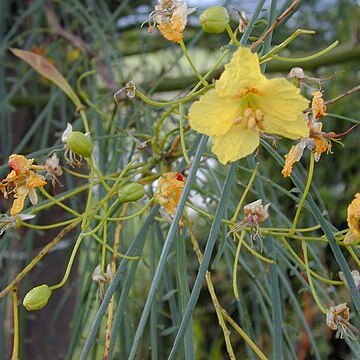Shrubs or trees, prickly or not. Leaves abruptly bipinnate; rachis very flattened; pinnae usually 2-4, appearing congested at first sight; stipules small, scaly to spinescent; rachis of pinnae very long and flattened; leaflets reduced, inconspicuous, numerous, opposite or alternate, small. Racemes or cymes axillary; bracts caducous, small. Pedicels long, without bracteoles. Flowers bisexual. Receptacle discoid. Sepals 5, slightly unequal, imbricate or subvalvate, membranous. Petals 5, spreading, slightly unequal, shortly clawed, uppermost broader and long clawed. Stamens 10, free, not exserted; filaments villous at bases; anthers ovoid, versatile, cells opening by lateral slits. Ovary shortly stalked, inserted at bottom of receptacle, glabrous to ± pubescent, many ovuled; style filiform, glabrous or pubescent; stigma truncate, ciliate or glabrous. Legume linear, torulose, not winged, indehiscent, thinly leathery. Seeds oblong; hilum small, near apex, with endosperm; cotyledons flat, fleshy; radicle straight.
although sometimes not obviously so because of (1) frequent fall of ultimate leaflets from flattened secondary rachis, and (2) extreme condensation of the primary rachis; pinnae few, approximate, almost "axillary" from the upper surface of a stout spine (spine--at least partially the modified petiole and primary rachis); stipules apparently modified as small lateral thorns from base of larger spine; leaf-lets of the pinna many, minute, often caducous; rachis of pinna flattened, green, eglandular. Inflorescence racemose, several-flowered, arising from the axils. Flowers moderate; calyx with a short, turbinate tube, the lobes imbricate, a few times longer than the tube; petals free, clawed, subequal; stamens 10, free, the anthers versatile and longitudinally dehiscent; ovary essentially free, straight, slender, subterete, scarcely stipitate. Legume tardily dehiscent, subterete and swollen at point of seed development, constricted and flattened between the seeds; seeds few, longitudinal.
Trees or shrubs, armed; branches slender, often pendent. Stipules spinescent, persistent or caducous. Leaves crowded on short shoots, spiral, bipinnate, 2 (4, or 6) opposite pinnae, the rachis of pinnae elongate, flattened, phyllodial. Leaflets small, numerous, along margins of pinnae, opposite or subopposite, caducous. Inflorescences of racemose units, crowded on short shoots; bracts and bracteoles absent or absent at anthesis. Flowers perfect, showy, fragrant. Hypanthium very short, obliquely campanulate. Calyx 5-lobed, lobes equal, deciduous. Petals 5, slightly zygomorphic or very zygomorphic, imbricate, clawed. Stamens 10, more or less equal or unequal in length, free, fertile; anthers introrsely or longitudinally dehiscent. Ovary stipitate, free, 6-15-ovuled; style filiform; stigma minute. Pods pendent, often externally constricted between the seeds, dehiscent, 1-10-seeded. Seeds albuminous.
Shrubs or trees, spinescent or unarmed, eglandular. Leaves bipinnate; stipules minute to conspicuous and spinescent; secondary rachises sometimes (in Australian species) ±phyllodial; leaflets opposite, alternate or (in Australian species) much-reduced or absent. Inflorescences in axillary racemes which are sometimes corymbose and short; bracts minute, deciduous. Flowers bisexual. Sepals 5, valvate to narrowly imbricate. Petals 5, subequal but the upper one usually modified and with a more pronounced claw. Stamens 10; filaments alternately longer and shorter; anthers dorsifixed. Ovary free, shortly stipitate; stigma truncate. Pod linear to ±elliptic, flat or turgid, not winged, indehiscent or dehiscent; valves usually chartaceous or thinly coriaceous. Seeds usually ±oblique or longitudinal, compressed.
Pods ± linear-elliptic to linear, flat or ± turgid, sometimes constricted between the seeds, indehiscent or the valves sometimes separating slightly from each other; seeds up to 8 but frequently only a few developing, usually longitudinally elongate in the pod with the hilum at one end, compressed, with endosperm.
Stamens 10, not or slightly exceeding the petals; filaments alternately longer and short, densely pubescent in the lower part; anthers dorsifixed dehiscing by longitudinal slits.
Leaves bipinnate, sometimes (in both F.Z. species) with the pinna rachis ± phyllodial and the leaflets very reduced or absent; stipules very small to conspicuous and spinescent.
Receptacle comprising a disc and a lower elongate part up to 10 mm long simulating the pedicel from which it is demarcated by a distinct joint.
Ovary shortly stipitate, glabrous to pubescent, with up to 8 ovules; style sometimes twisted; stigma truncate, ciliolate or glabrous.
Shrubs or small trees, not climbing, armed with spines (modified branches or leaf rachis) or unarmed, not glandular.
Sepals 5, valvate to narrowly imbricate (perhaps varying between flowers on the same plant), subglabrous.
Small trees or shrubs, the branches prominently armed. Leaves twice-pinnate,
Petals 5, subequal, the upper one usually with a distinct claw.
Flowers in long or short axillary racemes; bracts caducous.

